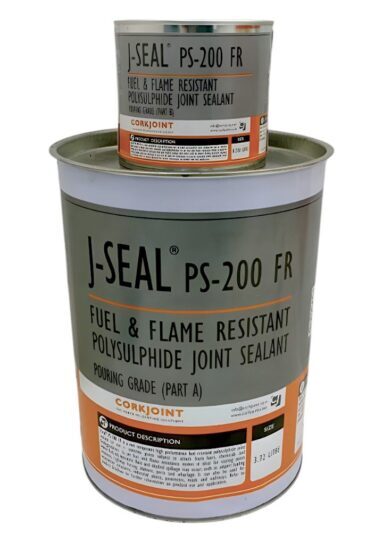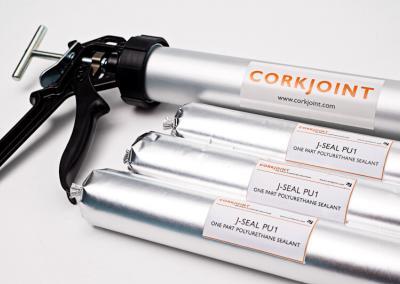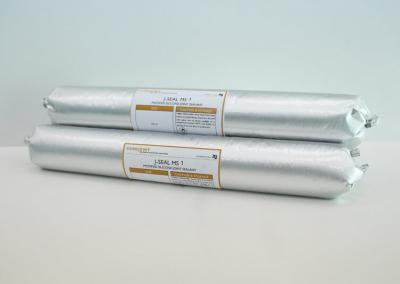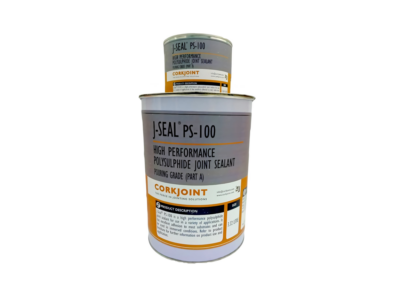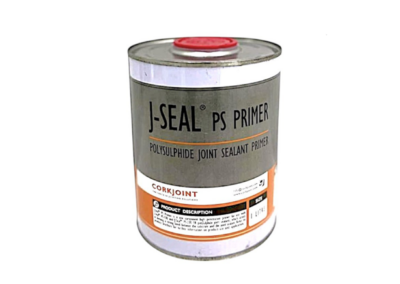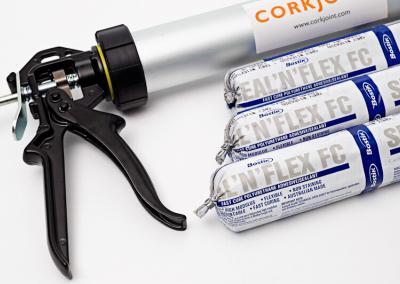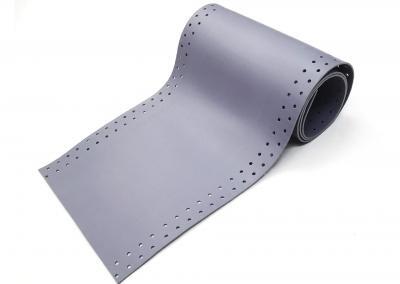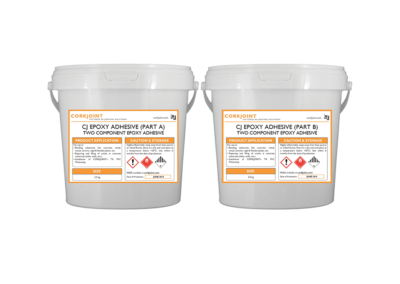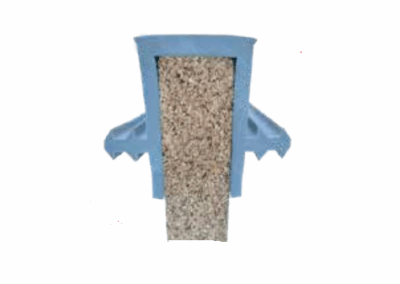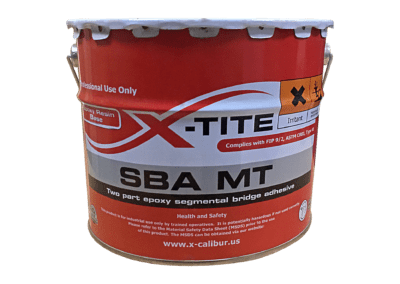J-SEAL® PS-200 FR Fuel and Flame Resistant Polysulphide Joint Sealant
Click on Images to view full screen
PRODUCT BROCHURE
PRODUCT SAFETY DATA SHEET – PART A
PRODUCT SAFETY DATA SHEET – PART B
Product Description
J-SEAL® PS-200 FR Fuel and Flame Resistant Polysulphide Joint Sealant is a two component high performance fuel resistant polysulphide joint sealant for use in concrete joints subject to attack from fuels, chemicals and biodegradation. Its jet fuel and flame resistance makes it ideal for sealing joints where fuel, oil, hydraulic fluid and skydrol spillage may occur, such as airport fueling locations, highway fueling stations, ports and wharfage. It can also be used for wastewater structures, industrial plants, pavements, roads and walkways.
Unlike many similar products on the market, J-Seal® PS-200 FR has been formulated to have a high level of ozone resistance. This results in an exceptionally high level of UV and weathering resistance leading to increased long term durability of the joint.
Advantages
- Meets SCAQMD Rule 1168 & LEED VOC Limits.
- Formaldehyde free.
- High ozone resistance.
- Durable resilient seal with excellent recovery characteristics.
- High early movement accommodation.
- Excellent application characteristics.
- Good fuel and chemical resistance.
- High bond strength to concrete & asphalt in dry & wet conditions.
- Available in gun and pouring grades.
Areas of Application
Sealing of movement and construction joints in :
- Structural floor joints subject to chemical spillage.
- Pavement joints subject to fuel spillage.
- Airport runways and taxiways.
- Concrete & Asphalt roads.
- Highways & Bridges.
- Oil & Gas Plants.
- Transport Depots.
- Warehouses & Industrial Factory floors.
Note : The product’s design and performance, its intended use, installation and final confirmation and approval for use, must be provided by the project’s Design Engineer and Project Manager.
Typical Applications

Specification Compliance
- British Standard BS EN 14188-2 : 2004.
- British Standard 5212:1990 Types N, F & FB.
- ASTM C920, Type M, Grade P, Class 25 for use T.
- US Fed Spec SS-S-200E.
- USCOE CRD-C 526-92.
- COE CRD-C 525.
- ASTM D5329 (Perfomance requirements, Type I).
- ASTM D5893 (Perfomance requirements, Type SL).
- ASTM D7116.
- ASTM D1149 Ozone Resistance.
- DCL Green Building Regulations.
- ASTM D1519 (Melting Temperature).
- SCAQMD Rule 1168 & LEED VOC Limits.
Chemical Resistance
J-Seal® PS-200 FR is resistant to the spillage of petrol, aviation fuel, diesel fuel, kerosene, lubrication oils, hydraulic fluid, skydrol and white spirit.
Physical Properties
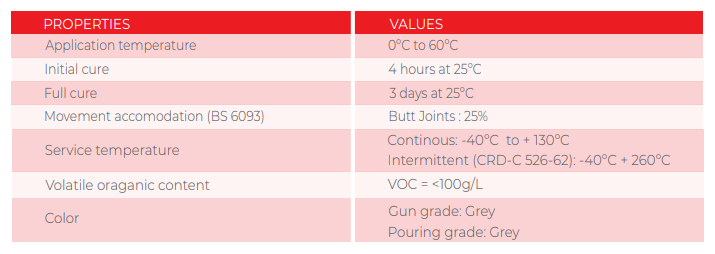
Packaging
Gun Grade : 2.5 litre tin containing base and curing agent in the same tin, separated by the color paste.
Pouring grade : 4 and 20 litre tin comprising separate base and curing agent.
J-Seal PS Primer : 1 litre tin.
Storage & Shelf Life
Store in a cool (at 5ºC to 25ºC), dry place and keep away from all sources of heat and sunlight. In tropical or hot climates, store in air-conditioned rooms. The shelf life is up to 12 months from date of manufacture, in un-opened condition and if stored as per recommendations. Excessive exposure to sunlight, heat and humidity, will result in the deterioration of the quality of the product and reduce its shelf life.
Joint Design Geometry
The width of the joint should be a minimum of 4 times the anticipated movement but within the maximum width requirements. Joints with cyclic movement should have a width to depth ratio of 2:1 and 1:1 for static joints. The joint depth shall not exceed the width.
The joint width and depth should be maintained as suggested:
JOINT WIDTH
5 mm (Minimum)
50 mm (Maximum)
JOINT DEPTH
5 mm (Minimum)
25 mm (Maximum)
Note : Wider joint widths may be applicable but check with CORKJOINT® for verification. Final joint sizes/geometry should be verified and approved by the Project’s Design Engineer.
Joint Design Considerations
- J-Seal® PS-200 FR has a movemen t accommodation factor (MAF) of 25%. It can be applied in joints of 5mm to 50mm wide.
- In order to allow movement to be accommodated over the full width of the sealant, it must be debonded at the base of the joint.
- Joints in concrete pavements are subject to vehicular traffic. Joint sealants should therefore always be fully supported and the sealant recessed to ensure that, at no time during the movement cycle, will the sealant extrude above the level of the pavement surface.
- For maximum performance, joint edges must be primed with J-Seal® PS Primer.
Limitations
J-Seal® PS-200 FR is not recommended for:
- Overhead joints.
- Movement joints having a Movement Accomodation Factor (MAF) of > 25%.
- Over painting with enamel or rigid paints (paint compatibility with sealant shall be checked prior to painting).
- Applied in joints wider than 50mm.
- Applied in joints less than 5mm in width and depth.
- Use for glazing applications.
- High and/or sharp point loads.
- Do not apply in rain or wet conditions, or at temperatures below 5ºC
- Do not part mix.
Guide to Quantities

Note : Calculation based on theoretical coverage. Actual material consumption at site will vary depending on the condition of the joints and wastage etc.
Typical Installations
INSTALLATION GUIDELINES
CORKJOINT® provides detailed method statements on all its products for use in various applications. These must be referred to prior to starting work. The information below is a summary intended for guidance only.
JOINT PREPARATION
Joints should be accurately formed and joint edges must be sound, dry and free from any contaminants. The joint sides must be prepared by grit blasting, grinding or by wire brushing to produce a rough clean surface. Care should be taken to ensure that the joint is formed to the required depth and any expansion joint filler is tightly packed in place. For joints in asphalt contact your CORKJOINT® representative or distributor for advice regarding priming and joint detailing.
PRIMING
Use J-Seal® PS Primer. The primer should be applied to the joint sides using a clean, dry paint brush. Work the primer well into the substrate. After application of primer, debond the joint using siliconized debonding tape over the joint filler board. J-Seal® PS-200 FR should be applied once the primer is touch dry. The sealant should be applied between 30 mins to 3 hours after priming. If the primer is left to dry longer than 3 hours, the surfaces must be reprimed prior to applying the sealant.
Mixing Procedures
GUN GRADE
The curing agent and base are packed in a single pack separated by the color paste. Mix with a J-Seal mixing paddle using a slow speed drill (400 to 500 rpm). Mix for 3 to 4 minutes to ensure complete mixing.
POURING GRADE
Add the entire contents of Part A (curing agent) to Part B (base component) and mix with a J-Seal mixing paddle using a slow speed drill (400 to 500rpm). Mix for 3 to 4 minutes to ensure complete mixing.
Application Instructions
GUN GRADE
Apply using a sealant gun or direct from the can using a spatula.
POURING GRADE
Apply using a sealant gun designed for pouring grade sealants, or use direct from the can. The joint sealant should be slightly recessed.
CLEANING
Clean equipment using a solvent cleaner. Remove all excess sealant with a scraper. Any spillage can be cleaned using solvent or xylene. Clean all tools and equipment using similar solvents immediately after the tooling. Hardened materials can only be removed mechanically.
LIMITATIONS
- Do not apply in rain or wet conditions or at temperatures below 0ºC.
- Do not part mix.
- Do not use in contact with asphalt.
- Do not expose to aggressive chemicals.
- Do not fully immerse the joint sealant until full cure is achieved.
- Use in swimming pools is limited to pools that pre-mix the chemical additives prior to dosing to the pool.
Health and Safety Information
Do not apply primer near smoke or naked flame. In case of fire, extinguish with carbon dioxide, dry chemical or foam fire extinguisher.
As with all construction chemical products caution should be exercised. Protective clothing such as gloves and goggles should be worn. Treat any splashes to the skin or eyes with fresh water immediately. Should any of the products be accidentally swallowed, do not induce vomiting, but call for medical assistance immediately.
In confined spaces or in still air conditions, the use of a ventilation fan or suitable respirator should be used, and the advice and approval of the Site Safety Supervisor is essential. For further information or advice on health and safety precautions, safe handling, storage and correct disposal of products, please refer to the most recent product Safety Data Sheet (SDS), which is available upon request.
Written Specification
Where shown in the drawings, the joint sealant shall be J-Seal® PS-200 FR fuel & flame resistant polysulphide joint sealant as supplied by CORKJOINT®. The application/installation of the product must be in accordance with the manufacturer’s recommendations, and J-Seal® PS Primer must be used in conjunction with the application of the joint sealant.
Product Validity
CORKJOINT® undertakes modifications to its product brochures on a continual basis, as and when required. Please check under the product summary section at www.corkjoint.com to ensure that you have the latest version of the product brochure.
Disclaimer
The information and the recommendations relating to the application and end use of this product are given in good faith and are based on the information provided by the manufacturer of the product and/or the Company’s current knowledge and experience in connection with the product when properly stored, handled and applied under normal conditions and no liability of final function at the job site is assumed. In practice, the differences in materials, substrates and actual site conditions are such that no warranty in respect of merchantability of, or fitness for, particular purpose, nor any liability arising out of any legal relationship whatsoever, can be inferred either from this information, or from any written and/or oral recommendations, or from any other advice offered by the Company. The Company also has no express or implied knowledge of any particular purpose for which the product is required and any such information given will not be taken into account in the supply of this product. No responsibility or liability by the Company will be accepted for misuse, misreading or derivation from recommended guidelines in respect of this product and the user shall determine the suitability of the product for his intended use and assume all risks and liability in connection therewith. The information contained in our brochure may change at any time without notice. Any use of this product, J-Seal® PS-200 FR, in any application should be approved as suitable for use/application by the Design Engineer and Project Manager.

